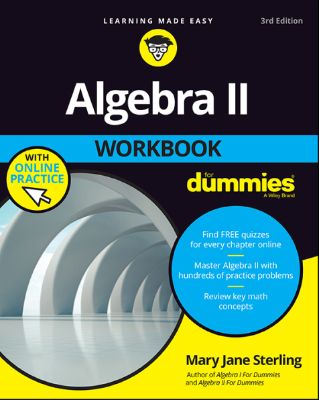
Lýsing:
Boost your chances of scoring higher at Algebra II Algebra II introduces students to complex algebra concepts in preparation for trigonometry and calculus. In this new edition of Algebra II Workbook For Dummies , high school and college students will work through the types of Algebra II problems they'll see in class, including systems of equations, matrices, graphs, and conic sections. Plus, the book now comes with free 1-year access to chapter quizzes online! A recent report by ACT shows that over a quarter of ACT-tested 2012 high school graduates did not meet any of the four college readiness benchmarks in mathematics, English, reading, and science.
Algebra II Workbook For Dummies presents tricky topics in plain English and short lessons, with examples and practice at every step to help students master the essentials, setting them up for success with each new lesson. Tracks to a typical Algebra II class Can be used as a supplement to classroom learning or for test prep Includes plenty of practice and examples throughout Comes with free access to chapter quizzes online Get ready to take the intimidation out of Algebra II!.
Annað
- Höfundur: Mary Jane Sterling
- Útgáfa:3
- Útgáfudagur: 14-12-2018
- Hægt að prenta út 10 bls.
- Hægt að afrita 2 bls.
- Format:ePub
- ISBN 13: 9781119543121
- Print ISBN: 9781119543114
- ISBN 10: 1119543126
Efnisyfirlit
- Cover
- Introduction
- About This Book
- Foolish Assumptions
- Icons Used in This Book
- Beyond the Book
- Where to Go from Here
- Part 1: Getting Started with Algebra II
- Chapter 1: Going Beyond Beginning Algebra
- Good Citizenship: Following the Order of Operations and Other Properties
- Specializing in Products and FOIL
- Variables on the Side: Solving Linear Equations
- Dealing with Linear Absolute Value Equations
- Greater Math Skills: Equalizing Linear Inequalities
- Answers to Problems on Going Beyond Beginning Algebra
- Chapter 2: Handling Quadratic (and Quadratic-Like) Equations and Inequalities
- Finding Reasonable Solutions with Radicals
- UnFOILed Again! Successfully Factoring for Solutions
- Your Bag of Tricks: Factoring Multiple Ways
- Keeping Your Act Together: Factoring by Grouping
- Resorting to the Quadratic Formula
- Solving Quadratics by Completing the Square
- Working with Quadratic-Like Equations
- Checking Out Quadratic Inequalities
- Answers to Problems on Quadratic (and Quadratic-Like) Equations and Inequalities
- Chapter 3: Rooting Out the Rational, the Radical, and the Negative
- Doing Away with Denominators with an LCD
- Simplifying and Solving Proportions
- Wrangling with Radicals
- Changing Negative Attitudes toward Negative Exponents
- Divided Powers: Solving Equations with Fractional Exponents
- Answers to Problems on Rooting Out the Rational, the Radical, and the Negative
- Chapter 4: Graphing for the Good Life
- Coordinating Axes, Coordinates of Points, and Quadrants
- Crossing the Line: Using Intercepts and Symmetry to Graph
- Graphing Lines Using Slope-Intercept and Standard Forms
- Graphing Basic Polynomial Curves
- Grappling with Radical and Absolute Value Functions
- Enter the Machines: Using a Graphing Calculator
- Answers to Problems on Graphing for the Good Life
- Chapter 1: Going Beyond Beginning Algebra
- Chapter 5: Formulating Functions
- Evaluating Functions
- Determining the Domain and Range of a Function
- Recognizing Even, Odd, and One-to-One Functions
- Composing Functions and Simplifying the Difference Quotient
- Solving for Inverse Functions
- Answers to Problems on Formulating Functions
- Chapter 6: Specializing in Quadratic Functions
- Finding Intercepts and the Vertex of a Parabola
- Applying Quadratics to Real-Life Situations
- Graphing Parabolas
- Answers to Problems on Quadratic Functions
- Chapter 7: Plugging in Polynomials
- Finding Basic Polynomial Intercepts
- Digging up More-Difficult Polynomial Roots with Factoring
- Determining Where a Function Is Positive or Negative
- Graphing Polynomials
- Possible Roots and Where to Find Them: The Rational Root Theorem and Descartes’s Rule
- Getting Real Results with Synthetic Division and the Remainder Theorem
- Connecting the Factor Theorem with a Polynomial’s Roots
- Answers to Problems on Plugging in Polynomials
- Chapter 8: Acting Rationally with Functions
- Determining Domain and Intercepts of Rational Functions
- Introducing Vertical and Horizontal Asymptotes
- Getting a New Slant with Oblique Asymptotes
- Removing Discontinuities
- Going the Limit: Limits at a Number and Infinity
- Graphing Rational Functions
- Answers to Problems on Rational Functions
- Chapter 9: Exposing Exponential and Logarithmic Functions
- Evaluating e-Expressions and Powers of e
- Solving Exponential Equations
- Making Cents: Applying Compound Interest and Continuous Compounding
- Checking out the Properties of Logarithms
- Presto-Chango: Expanding and Contracting Expressions with Log Functions
- Solving Logarithmic Equations
- They Ought to Be in Pictures: Graphing Exponential and Logarithmic Functions
- Answers to Problems on Exponential and Logarithmic Functions
- Chapter 10: Any Way You Slice It: Conic Sections
- Putting Equations of Parabolas in Standard Form
- Shaping Up: Determining the Focus and Directrix of a Parabola
- Back to the Drawing Board: Sketching Parabolas
- Writing the Equations of Circles and Ellipses in Standard Form
- Determining Foci and Vertices of Ellipses
- Rounding Out Your Sketches: Circles and Ellipses
- Hyperbola: Standard Equations and Foci
- Determining the Asymptotes and Intercepts of Hyperbolas
- Sketching the Hyperbola
- Answers to Problems on Conic Sections
- Chapter 11: Solving Systems of Linear Equations
- Solving Two Linear Equations Algebraically
- Using Cramer’s Rule to Defeat Unruly Fractions
- A Third Variable: Upping the Systems to Three Linear Equations
- A Line by Any Other Name: Writing Generalized Solution Rules
- Decomposing Fractions Using Systems
- Answers to Problems on Systems of Equations
- Chapter 12: Solving Systems of Nonlinear Equations and Inequalities
- Finding the Intersections of Lines and Parabolas
- Crossing Curves: Finding the Intersections of Parabolas and Circles
- Appealing to a Higher Power: Dealing with Exponential Systems
- Solving Systems of Inequalities
- Answers to Problems on Solving Systems of Nonlinear Equations and Inequalities
- Chapter 13: Getting More Complex with Imaginary Numbers
- Simplifying Powers of i
- Not Quite Brain Surgery: Doing Operations on Complex Numbers
- “Dividing” Complex Numbers with a Conjugate
- Solving Equations with Complex Solutions
- Answers to Problems on Imaginary Numbers
- Chapter 14: Getting Squared Away with Matrices
- Describing Dimensions and Types of Matrices
- Adding, Subtracting, and Doing Scalar Multiplication on Matrices
- Trying Times: Multiplying Matrices by Each Other
- The Search for Identity: Finding Inverse Matrices
- Using Matrices to Solve Systems of Equations
- Answers to Problems on Matrices
- Chapter 15: Going Out of Sequence with Sequences and Series
- Writing the Terms of a Sequence
- Differences and Multipliers: Working with Special Sequences
- Backtracking: Constructing Recursively Defined Sequences
- Using Summation Notation
- Finding Sums with Special Series
- Answers to Problems on Sequences and Series
- Chapter 16: Everything You Ever Wanted to Know about Sets and Counting
- Writing the Elements of a Set from Rules or Patterns
- Get Together: Combining Sets with Unions, Intersections, and Complements
- Multiplication Countdowns: Simplifying Factorial Expressions
- Checking Your Options: Using the Multiplication Property
- Counting on Permutations When Order Matters
- Mixing It Up with Combinations
- Raising Binomials to Powers: Investigating the Binomial Theorem
- Answers to Problems on Sets and Counting
- Chapter 17: Basic Graphs
- Putting Polynomials in Their Place
- Lining Up Front and Center
- Being Absolutely Sure with Absolute Value
- Graphing Reciprocals of x and x2
- Rooting Out Square Root and Cube Root
- Growing Exponentially with a Graph
- Logging In on Logarithmic Graphing
- Chapter 18: Ten Special Sequences and Their Sums
- Adding as Easy as One, Two, Three
- Summing Up the Squares
- Finding the Sum of the Cubes
- Not Being at Odds with Summing Odd Numbers
- Evening Things Out by Adding Up Even Numbers
- Adding Everything Arithmetic
- Geometrically Speaking
- Easing into a Sum for e
- Signing In on the Sine
- Powering Up on Powers of 2
- Adding Up Fractions with Multiples for Denominators
UM RAFBÆKUR Á HEIMKAUP.IS
Bókahillan þín er þitt svæði og þar eru bækurnar þínar geymdar. Þú kemst í bókahilluna þína hvar og hvenær sem er í tölvu eða snjalltæki. Einfalt og þægilegt!Rafbók til eignar
Rafbók til eignar þarf að hlaða niður á þau tæki sem þú vilt nota innan eins árs frá því bókin er keypt.
Þú kemst í bækurnar hvar sem er
Þú getur nálgast allar raf(skóla)bækurnar þínar á einu augabragði, hvar og hvenær sem er í bókahillunni þinni. Engin taska, enginn kyndill og ekkert vesen (hvað þá yfirvigt).
Auðvelt að fletta og leita
Þú getur flakkað milli síðna og kafla eins og þér hentar best og farið beint í ákveðna kafla úr efnisyfirlitinu. Í leitinni finnur þú orð, kafla eða síður í einum smelli.
Glósur og yfirstrikanir
Þú getur auðkennt textabrot með mismunandi litum og skrifað glósur að vild í rafbókina. Þú getur jafnvel séð glósur og yfirstrikanir hjá bekkjarsystkinum og kennara ef þeir leyfa það. Allt á einum stað.
Hvað viltu sjá? / Þú ræður hvernig síðan lítur út
Þú lagar síðuna að þínum þörfum. Stækkaðu eða minnkaðu myndir og texta með multi-level zoom til að sjá síðuna eins og þér hentar best í þínu námi.
Fleiri góðir kostir
- Þú getur prentað síður úr bókinni (innan þeirra marka sem útgefandinn setur)
- Möguleiki á tengingu við annað stafrænt og gagnvirkt efni, svo sem myndbönd eða spurningar úr efninu
- Auðvelt að afrita og líma efni/texta fyrir t.d. heimaverkefni eða ritgerðir
- Styður tækni sem hjálpar nemendum með sjón- eða heyrnarskerðingu
- Gerð : 208
- Höfundur : 10694
- Útgáfuár : 2018


